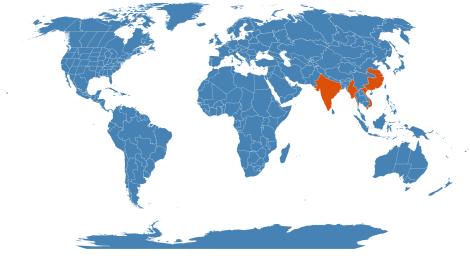Accession Data
Alpinia calcarata
Family: Zingiberaceae
Country of Origin: China (Guangdong) to Indo-China
Description: Leafy stem up to 1.5 m high. Leaves sessile, lamina glabrous, linear-lanceolate. Ligule membraneous, bifid. Inflorescence terminal, 10-15 cm long, peduncle densely pubescent. Bracts minute, triangular, pubescent. Flowers shortly pedicellate, calyx tubular. Corolla tube almost equal to the calyx, lobes oblong. Labellum obovate, variegated with dark purple and yellow, glabrous. Stamen shorter than labellum, anther thecae parallel, pubescent. Epigynous glands two, free from each other. Ovary trilocular with many ovules. Fruit globose, orange-red, seeds many.3
Uses: Stimulates digestion, purifies blood and improves voice. Rhizomes are anti-inflammatory. One study found the cytotoxic activity of ethanol extract of Alpinia calcarata, the rhizome, against Ehrlich ascites carcinoma tumor bearing Swiss Albino mice and concluded that the plant rhizome can be considered as a probable new source of antitumor agents.3
Accession Data
Accession #: 1151
Bloom Status: 🪴 Not Flowering
Quantity: 1
Source: Kress Collection, SI#1994759
Provenance: Collector# 87-2215 Kress, W. J. ex hort., United States: Hawaii plant given to U.S. Bot. Garden 15 June 2016
Classification
Division: Magnoliophyta
Class: Liliopsida
Subclass: commelinids
Order: Zingiberales
Family: Zingiberaceae
SubFamily: Alpinioideae
Tribe: Alpinieae
References
- The Plant List (2013). Version 1.1. Last accessed on Saturday, 04 May, 2019.
- WCSP (2019). World Checklist of Selected Plant Families. Facilitated by the Royal Botanic Gardens, Kew. Last accessed on Saturday, 04 May, 2019.
- Kumar KM, Asish GR, Sabu M, Balachandran I. , Significance of gingers (Zingiberaceae) in Indian System of Medicine - Ayurveda: An overview. Anc Sci Life. 2013;32(4):253–261. doi:10.4103/0257-7941.131989. Last accessed on Wednesday, 22 May, 2019.
- Medicinal Plants Names Service at Kew. Last accessed on Wednesday, 22 May, 2019.
Images

